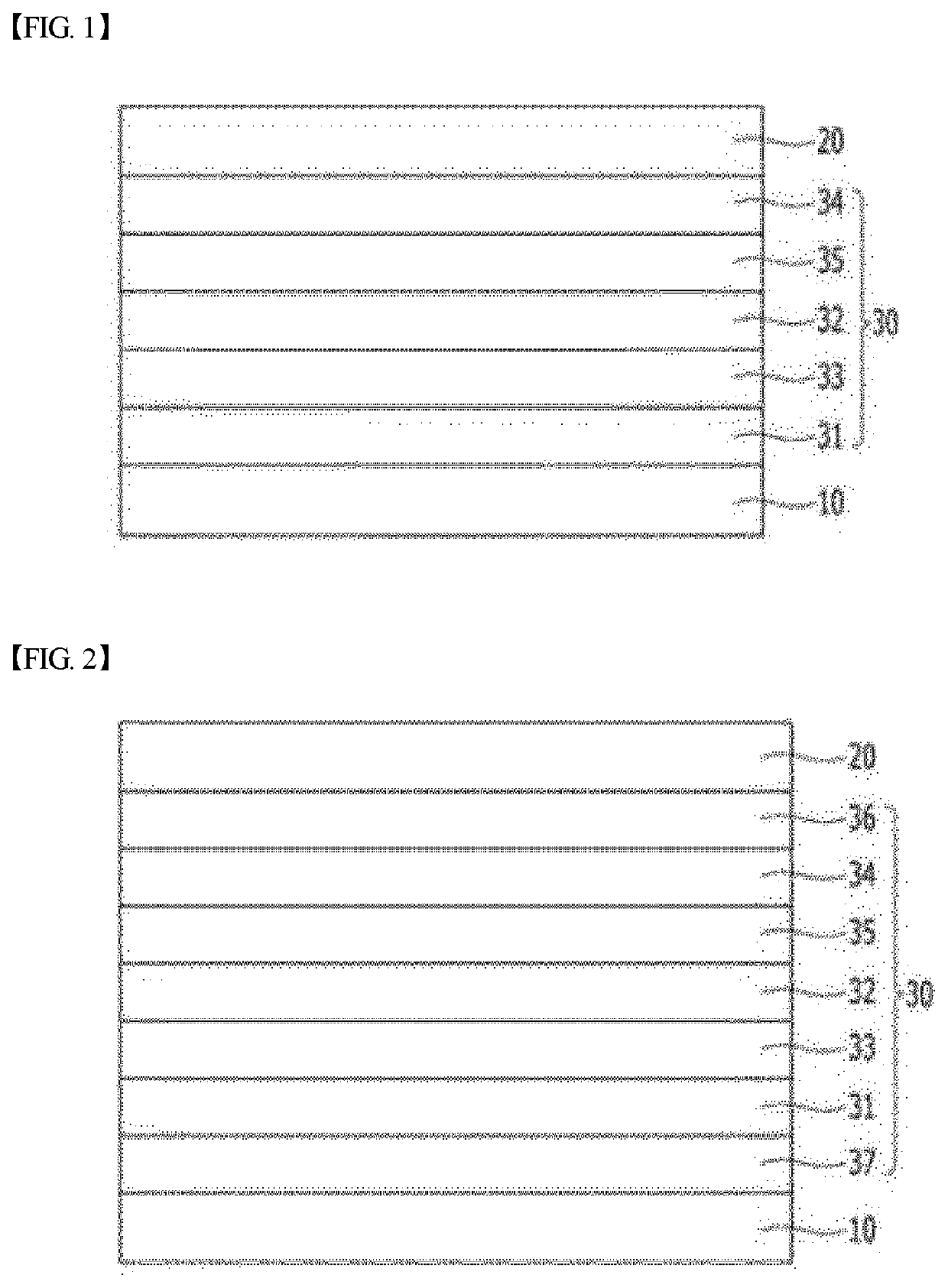Organic compound and organic electroluminescent device comprising same
a technology of organic electroluminescent devices and compounds, which is applied in the direction of luminescent compositions, organic chemistry, chemistry apparatuses and processes, etc., can solve the problems of unsatisfactory lifetime of organic electroluminescent devices and unfavorable thermal stability, and achieve the effects of enhancing the properties of light emitting performance, and reducing the cost of production
- Summary
- Abstract
- Description
- Claims
- Application Information
AI Technical Summary
Benefits of technology
Problems solved by technology
Method used
Image
Examples
preparation example 1
Synthesis of A1
[0150]
[0151]Under a nitrogen stream, 3-(3-bromophenyl)-1-phenyl-1H-indazole (8.5 g, 24.4 mmol), 4,4,4′,4′,5,5,5′,5′-octamethyl-2,2′-bi(1,3,2-dioxaborolane) (7.4 g, 29.2 mmol), Pd(dppf)Cl2 (0.6 g, 0.7 mmol), KOAc (7.2 g, 73.1 mmol) and 1,4-dioxane (200 ml) were mixed, and stirred for 6 hours at 130° C.
[0152]After the reaction was finished, the result was extracted with ethyl acetate, the moisture was removed using MgSO4, and the result was purified using column chromatography to obtain target Compound Al (6.8 g, 17.1 mmol, yield 70%).
[0153]GC-Mass (theoretical value: 396.3 g / mol, measured value: 396 g / mol)
[0154]1H-NMR: δ 1.25 (s, 12H), 7.45˜7.55 (m, 8H), 7.62 (s, 1H), 7.84˜92 (m, 4H)
preparation example 2
Synthesis of A2
[0155]
[0156]Under a nitrogen stream, 3-(3-bromophenyl)-1-(pyridin-4-yl)-1H-indazole (8.5 g, 24.4 mmol), 4,4,4′,4′,5,5,5′,5′-octamethyl-2,2′-bi(1,3,2-dioxaborolane) (7.4 g, 29.2 mmol), Pd(dppf)Cl2 (0.6 g, 0.7 mmol), KOAc (7.2 g 73.1 mmol) and 1,4-dioxane (200 ml) were mixed, and stirred for 6 hours at 130° C.
[0157]After the reaction was finished, the result was extracted with ethyl acetate, the moisture was removed using MgSO4, and the result was purified using column chromatography to obtain target Compound A2 (7.3 g, 18.3 mmol, yield 75%).
[0158]GC-Mass (theoretical value: 397.3 g / mol, measured value: 397 g / mol)
[0159]1H-NMR: δ 1.25 (s, 12H), 7.45˜7.55 (m, 5H), 7.62 (s, 1H), 7.84˜92 (m, 4H), 8.11˜12 (d, 2H)
preparation example 3
Synthesis of A3
[0160]
[0161]Under a nitrogen stream, 3-(3-bromophenyl)-1,5-diphenyl-1H-indazole (10.4 g, 24.4 mmol), 4,4,4′,4′,5,5,5′,5′-octamethyl-2,2′-bi(1,3,2-dioxaborolane) (7.4 g, 29.2 mmol), Pd(dppf)Cl2 (0.6 g, 0.7 mmol), KOAc (7.2 g 73.1 mmol) and 1,4-dioxane (200 ml) were mixed, and stirred for 6 hours at 130° C.
[0162]After the reaction was finished, the result was extracted with ethyl acetate, the moisture was removed using MgSO4, and the result was purified using column chromatography to obtain target Compound A3 (8.6 g, 18.3 mmol, yield 75%).
[0163]GC-Mass (theoretical value: 472.4 g / mol, measured value: 472 g / mol)
[0164]1H-NMR: δ 1.25 (s, 12H), 7.44˜7.59 (m, 14H), 7.62 (s, 1H), 8.23˜25 (d, 2H)
PUM
| Property | Measurement | Unit |
|---|---|---|
| current density | aaaaa | aaaaa |
| Chemical Formula | aaaaa | aaaaa |
| Chemical Formulae | aaaaa | aaaaa |
Abstract
Description
Claims
Application Information
 Login to View More
Login to View More - R&D
- Intellectual Property
- Life Sciences
- Materials
- Tech Scout
- Unparalleled Data Quality
- Higher Quality Content
- 60% Fewer Hallucinations
Browse by: Latest US Patents, China's latest patents, Technical Efficacy Thesaurus, Application Domain, Technology Topic, Popular Technical Reports.
© 2025 PatSnap. All rights reserved.Legal|Privacy policy|Modern Slavery Act Transparency Statement|Sitemap|About US| Contact US: help@patsnap.com



